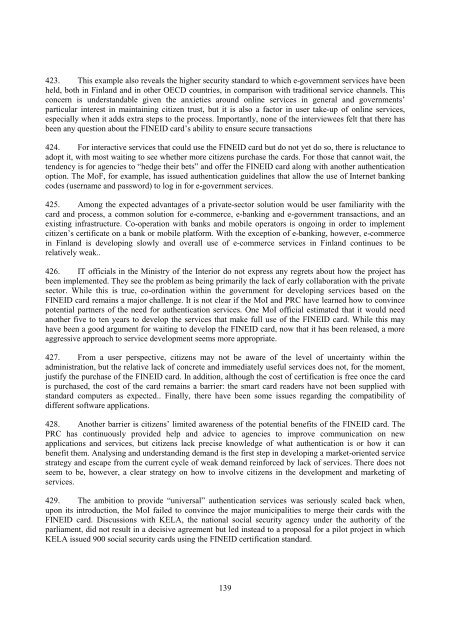e-GOVERNMENT IN FINLAND - ePractice.eu
e-GOVERNMENT IN FINLAND - ePractice.eu
e-GOVERNMENT IN FINLAND - ePractice.eu
You also want an ePaper? Increase the reach of your titles
YUMPU automatically turns print PDFs into web optimized ePapers that Google loves.
423. This example also reveals the higher security standard to which e-government services have been<br />
held, both in Finland and in other OECD countries, in comparison with traditional service channels. This<br />
concern is understandable given the anxieties around online services in general and governments’<br />
particular interest in maintaining citizen trust, but it is also a factor in user take-up of online services,<br />
especially when it adds extra steps to the process. Importantly, none of the interviewees felt that there has<br />
been any question about the F<strong>IN</strong>EID card’s ability to ensure secure transactions<br />
424. For interactive services that could use the F<strong>IN</strong>EID card but do not yet do so, there is reluctance to<br />
adopt it, with most waiting to see whether more citizens purchase the cards. For those that cannot wait, the<br />
tendency is for agencies to “hedge their bets” and offer the F<strong>IN</strong>EID card along with another authentication<br />
option. The MoF, for example, has issued authentication guidelines that allow the use of Internet banking<br />
codes (username and password) to log in for e-government services.<br />
425. Among the expected advantages of a private-sector solution would be user familiarity with the<br />
card and process, a common solution for e-commerce, e-banking and e-government transactions, and an<br />
existing infrastructure. Co-operation with banks and mobile operators is ongoing in order to implement<br />
citizen’s certificate on a bank or mobile platform. With the exception of e-banking, however, e-commerce<br />
in Finland is developing slowly and overall use of e-commerce services in Finland continues to be<br />
relatively weak..<br />
426. IT officials in the Ministry of the Interior do not express any regrets about how the project has<br />
been implemented. They see the problem as being primarily the lack of early collaboration with the private<br />
sector. While this is true, co-ordination within the government for developing services based on the<br />
F<strong>IN</strong>EID card remains a major challenge. It is not clear if the MoI and PRC have learned how to convince<br />
potential partners of the need for authentication services. One MoI official estimated that it would need<br />
another five to ten years to develop the services that make full use of the F<strong>IN</strong>EID card. While this may<br />
have been a good argument for waiting to develop the F<strong>IN</strong>EID card, now that it has been released, a more<br />
aggressive approach to service development seems more appropriate.<br />
427. From a user perspective, citizens may not be aware of the level of uncertainty within the<br />
administration, but the relative lack of concrete and immediately useful services does not, for the moment,<br />
justify the purchase of the F<strong>IN</strong>EID card. In addition, although the cost of certification is free once the card<br />
is purchased, the cost of the card remains a barrier: the smart card readers have not been supplied with<br />
standard computers as expected.. Finally, there have been some issues regarding the compatibility of<br />
different software applications.<br />
428. Another barrier is citizens’ limited awareness of the potential benefits of the F<strong>IN</strong>EID card. The<br />
PRC has continuously provided help and advice to agencies to improve communication on new<br />
applications and services, but citizens lack precise knowledge of what authentication is or how it can<br />
benefit them. Analysing and understanding demand is the first step in developing a market-oriented service<br />
strategy and escape from the current cycle of weak demand reinforced by lack of services. There does not<br />
seem to be, however, a clear strategy on how to involve citizens in the development and marketing of<br />
services.<br />
429. The ambition to provide “universal” authentication services was seriously scaled back when,<br />
upon its introduction, the MoI failed to convince the major municipalities to merge their cards with the<br />
F<strong>IN</strong>EID card. Discussions with KELA, the national social security agency under the authority of the<br />
parliament, did not result in a decisive agreement but led instead to a proposal for a pilot project in which<br />
KELA issued 900 social security cards using the F<strong>IN</strong>EID certification standard.<br />
139
















